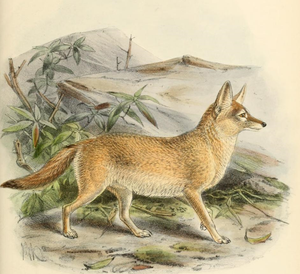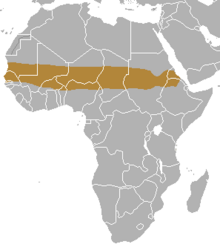Pale fox
| Pale fox | ||||||||||||
|---|---|---|---|---|---|---|---|---|---|---|---|---|

Pale fox ( Vulpes pallida ) |
||||||||||||
| Systematics | ||||||||||||
|
||||||||||||
| Scientific name | ||||||||||||
| Vulpes pallida | ||||||||||||
| ( Cretzschmar , 1827) |
The pale fox ( Vulpes pallida ) is a species of the real fox (Vulpini). It is common in Africa in the semi-desert areas south of the Sahara .
features
The pale fox is similar to the Cape fox found in southern Africa . The legs and ears are quite long, the latter rounded at the tips. The basic color is pale beige, legs and occasionally the back are reddish brown. The underside, face and insides of the ears are lighter, sometimes almost white. In contrast to the roughly equal sized Rüppellfuchs ( Vulpes ruepelli ), the pale fox has a black tip of its tail. The tooth formula is 3 / 3-1 / 1-4 / 4-2 / 3 = 42.
It reaches a shoulder height of 25 centimeters and a head-torso length of 45 centimeters. His body weight is around 2 to 3.6 kilograms.
Pale foxes are well adapted to the habitat. They tolerate the high heat that occurs in dry times and hardly need any water. They probably get liquid from the fruits and prey they eat. However, they cannot do without water entirely.
Distribution area
The distribution area of the pale fox is in the semi-desert areas of northern Africa south of the Sahara. It stretches from the Atlantic to the Red Sea and roughly corresponds to the Sahel zone and the drier parts of the geographic Sudan adjacent to the south . It includes parts of the states Mauritania , Mali , Senegal , Gambia , Nigeria , Niger , Burkina Faso , Benin , Cameroon , Chad , Sudan and South Sudan , Ethiopia and Eritrea .
Way of life
The pale fox lives in dry savannas and semi-deserts and occasionally penetrates into real deserts . Apparently he lives together in small family groups that consist of a breeding couple and their offspring.
The nocturnal animals spend the day in self-dug caves in the ground, which can be up to 15 m long, 2–3 m deep and are inhabited by several animals. A litter consists of 3–4 puppies. The wearing time is between 51 and 53 days. The well-developed molars are striking, which allows conclusions to be drawn about their food: they mostly eat berries, melons and other parts of plants, but also ground-nesting birds, smaller animals and carrion.
Systematics
|
Phylogenetic classification of the genus Vulpes
|
The first scientific description of the pale fox comes from Philipp Jakob Cretzschmar in 1827. Today it is classified in the genus Vulpes along with eleven other species . On the basis of morphological and molecular biological data, it was classified by Binninda-Emonds and others in 1999 in a common group with the Cape fox ( V. chama ) and the Bengal fox ( V. bengalensis ) and compared to the remaining species of foxes as a sister group .
In addition to the nominate form Vulpes pallida pallida , 5 subspecies are described, of which the bottom 4 are recognized:
- Vulpes pallida cyrenaica
- Vulpes pallida Sudab from Korbofan to Dongalo
- Vulpes pallida edwardsi Mali and Senegal
- Vulpes pallida harterti Northern Nigeria to Air in Niger
- Vulpes pallida oertzeni Nigeria, North Cameroon, Chad to Libya in the north and Sudanese Darvo province in the south.
Threat and protection
The International Union for Conservation of Nature and Natural Resources (IUCN) classifies the species as “Least Concern”, as an acute threat to the stocks is not assumed. It should be noted that there is no detailed information on the size of the population, but the size of the area of distribution and the lack of threats to the population as a whole do not suggest classification in a hazard category.
supporting documents
- ↑ a b c d e Claudio Sillo: The desert-dwelling foxes of the old world . In: Udo Gansloßer, Claudio Silleo-Zubiri (ed.): Wild dogs . Filander Verlag, 2006, ISBN 3-930831-63-5 , Der Blassfuchs, p. 161 ff .
- ↑ a b c Vulpes pallida in the IUCN Red List of Threatened Species 2012.2. Posted by: C. Sillero-Zubiri, T. Wacher, 2008. Retrieved April 1, 2013.
- ↑ a b O. RP Binninda-Emonds, JL Gittleman, A. Purvis: Building large trees by combining phylogenetic information: a complete phylogeny of the extant carnovora (Mammalia). In: Biological Reviews of the Cambridge Philosophical Society. 74, 1999, pp. 143-175.
- ↑ Don E. Wilson, DeeAnn M. Reeder (eds.): Vulpes pallida . In: Mammal Species of the World. A Taxonomic and Geographic Reference. 3. Edition. 2005, ISBN 0-8018-8221-4 .
literature
- Ronald M. Nowak: Walker's Mammals of the World . Johns Hopkins University Press, 1999, ISBN 0-8018-5789-9 .
- Chris & Tilde Stuart: Field Guide to the Larger Mammals of Africa . Struik, 2000, ISBN 1-86872-534-0 .
- Jean Dorst, Pierre Dandelot: Mammals of Africa . Paul Parey Publishing House, 1970, ISBN 3-490-01018-3 .
Web links
- Canid Specialist Group: Pale fox (Vulpes pallida )
- Vulpes pallida inthe IUCN 2012 Red List of Threatened Species . 2. Posted by: C. Sillero-Zubiri, T. Wacher, 2008. Retrieved April 1, 2013.
